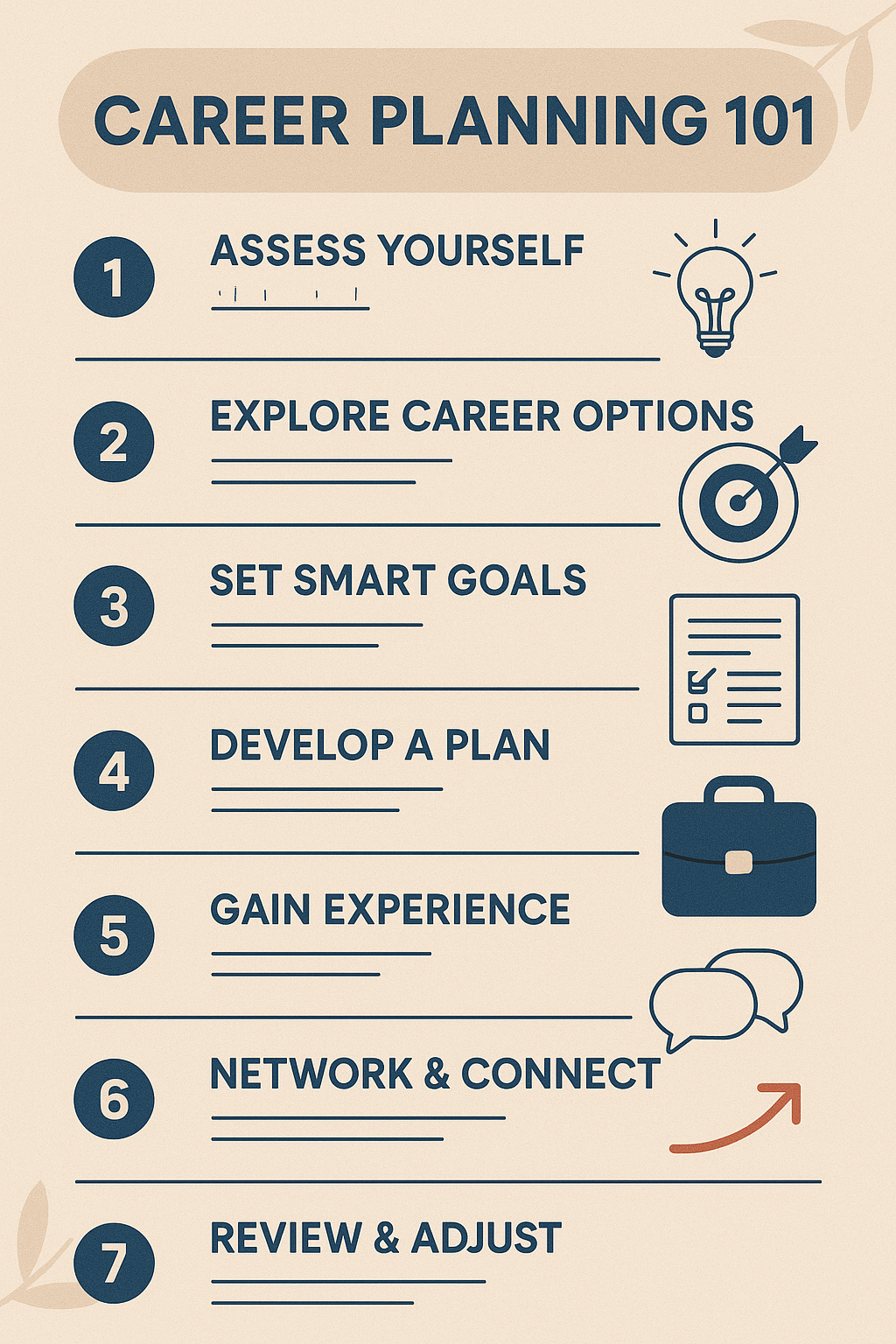Career Planning 101: Steps to a Successful Future
This guide offers a detailed roadmap to help you navigate the process and make informed, strategic decisions for long-term success.

In today’s rapidly evolving job market, career planning is more essential than ever. Whether you’re a student mapping out your future, a recent graduate stepping into the workforce, or a professional considering a change, understanding the core elements of career planning can empower you to take control of your professional journey. This guide offers a detailed roadmap to help you navigate the process and make informed, strategic decisions for long-term success.

What is Career Planning?
Career planning is a lifelong process of setting career goals and developing strategies to achieve them. It involves self-assessment, exploring career options, setting realistic objectives, and continuously upgrading skills to remain relevant and competitive in the job market.
Step 1: Self-Assessment
The first step in effective career planning is understanding yourself. Self-assessment helps you identify your interests, values, strengths, and weaknesses. Tools like the Myers-Briggs Type Indicator (MBTI), Holland Code (RIASEC), and SWOT analysis can provide valuable insights.
Ask yourself questions such as:
- What activities energize me?
- What skills do I excel at?
- What values are most important in my work life?
Understanding your personal preferences helps you align your career choices with your personality and long-term aspirations.
Step 2: Research Career Options
Once you have a better sense of who you are, begin exploring potential careers. Research industries, job roles, required qualifications, and potential growth. Use online job portals, company websites, government labor statistics, and career counseling services.
Consider factors such as:
- Job responsibilities
- Required education and skills
- Average salary
- Job outlook and growth opportunities
- Work-life balance and company culture
This research helps you narrow down your choices and identify roles that resonate with your goals and lifestyle.
Step 3: Set SMART Career Goals
Setting goals gives your career planning efforts direction and purpose. Use the SMART framework to create Specific, Measurable, Achievable, Relevant, and Time-bound objectives.
For example:
- Short-term goal: Complete a certification in digital marketing within 3 months.
- Long-term goal: Become a senior marketing manager within 5 years.
Breaking your goals into manageable steps makes them more attainable and helps you track your progress effectively.
Step 4: Acquire Necessary Education and Skills
Based on your chosen career path, identify the qualifications and skills required. This could include formal education, online courses, internships, or certifications.
Some effective learning platforms include:
- Coursera
- edX
- Udemy
- LinkedIn Learning
Don’t forget to work on soft skills such as communication, leadership, time management, and adaptability. These are often just as important as technical skills in many careers.
Step 5: Build a Strong Professional Network
Networking is a key component of career planning. Building relationships with professionals in your field can open doors to opportunities, mentorship, and valuable industry insights.
Attend events, join professional associations, and leverage platforms like LinkedIn to connect with peers and thought leaders. Don’t hesitate to reach out for informational interviews to learn more about roles or companies you’re interested in.
Step 6: Gain Experience
Experience is critical for building your resume and understanding your chosen field. Look for internships, part-time jobs, freelancing gigs, or volunteer opportunities that align with your career goals.
Real-world experience enhances your skills, builds your confidence, and gives you a competitive edge when applying for full-time roles.
Step 7: Create a Professional Resume and Online Presence
Your resume is your personal marketing tool. Tailor it for each job application by highlighting relevant skills and accomplishments. Use active language and quantify your achievements when possible.
In addition, maintain a professional online presence. Ensure your LinkedIn profile is up to date and consistent with your resume. Share relevant content, engage with industry discussions, and showcase your expertise to attract potential employers.
Step 8: Prepare for Job Applications and Interviews
Career planning includes preparing for the job search process. Start by identifying job openings that align with your goals. Customize your resume and cover letter for each role, using keywords from the job description.
Prepare for interviews by researching the company and practicing answers to common interview questions. Use the STAR method (Situation, Task, Action, Result) to effectively structure your responses.
Step 9: Evaluate Job Offers Thoughtfully
Not every job offer is the right one. Take time to evaluate each offer based on salary, benefits, company culture, career growth opportunities, and work-life balance.
Consider how the role fits into your long-term career planning. It’s better to wait for the right opportunity than to accept a position that doesn’t align with your goals.
Step 10: Review and Revise Your Career Plan Regularly
Career planning is not a one-time activity. Revisit your plan regularly to assess your progress, reflect on your experiences, and adjust your goals as needed. The job market and your interests may change over time, so staying flexible and proactive is essential.
Keep learning, stay informed about industry trends, and be open to new opportunities that align with your evolving vision.
Conclusion
Effective career planning is the foundation for a fulfilling and successful professional life. By following these ten steps—from self-assessment to regular review—you can make informed decisions, set realistic goals, and build a career that aligns with your passions and values.
Remember, career planning is a journey, not a destination. With clarity, determination, and the right strategy, you can confidently navigate the path to your desired future. For more guidance on career planning, explore additional resources and tools available at naukriytes.com and take your first step toward a successful future today.


